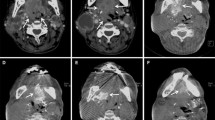Abstract
The aim of this study is to identify a surgical safe zone in base of tongue surgery. Fifteen Fresh frozen cadavers (30 head and neck regions) were included in the anatomical study. Twenty-two CT-angiogram (CTA) scans of neck were included in the radiological study. Surgical safe zone for base of tongue surgery was studied in cadavers and correlated the same in CTA. Depth of the lingual artery (LA) from the tongue surface and distance of origin of lingual artery from tip of greater cornu of hyoid bone was significantly different when comparing anatomical to radiological study (p < 0.005). On protruded position of tongue, lingual artery appeared more close to the tongue surface and was never encountered posterior to foramen caecum. Preoperative CTA evaluation would over-estimate the depth of LA putting the lingual artery at risk during resection. A surgical safe zone exists posterior to foramen caecum and towards the midline.


Similar content being viewed by others
References
Dallan I, Seccia V, Faggioni L et al (2013) Anatomical landmarks for transoral robotic tongue base surgery: comparison between endoscopic, external and radiological perspectives. Surg Radiol Anat 35(1):3–10
Tirelli G, Boscolo Nata F, Piovesana M, Quatela E, Gardenal N, Hayden RE (2018) Transoral surgery (TOS) in oropharyngeal cancer: different tools, a single mini-invasive philosophy. Surg Oncol 27:643–649
Hou T, Shao J, Fang S (2012) The definition of the V zone for the safety space of functional surgery of the tongue. Laryngoscope 122:66–70
Wu D, Qin J, Guo X, Li S (2014) Analysis of the difference in the course of the lingual arteries caused by tongue position change. The Laryngoscope 125(3):762–766
Lemaire V, Jacquemin G, Nelissen X et al (2005) Tip of the greater horn of the hyoid bone: a landmark for cervical surgery. Surg Radiol Anat 27:33
Lopez R, Lauwers F, Paoli J, Boutault F, Guitard J (2007) Vascular territories of the tongue: anatomical study and clinical applications. Surg Radiol Anat 29(3):239–244
Moore E, Janus J, Kasperbauer J (2011) Transoral robotic surgery of the oropharynx: clinical and anatomic considerations. Clin Anat 25(1):135–141
Lauretano AM, Li KK, Caradonna DS, Khosta RK, Fried MP (1997) Anatomic location of the tongue base neurovascular bundle. Laryngoscope 107:1057–1059
Hou T, Zhou L, Hu H (2011) Computed tomographic angiography study of the relationship between the lingual artery and lingual markers in patients with obstructive sleep apnoea. Clin Radiol 66(6):526–529
Ye J, Wang J, He L, Han D (2001) Anatomic characteristics of lingual artery and midline glossectomy. Chin J Otorhinolaryngol 36:55–57
Li S, Shi H (2013) Lingual artery CTA-guided midline partial glossectomy for treatment of obstructive sleep apnea hypopnea syndrome. Acta Otolaryngol 133(7):749–754
Li Sh, Shi HJ, Wu DH, Bao JM, Yang BQ, Dong WD et al (2009) Study of lingual arterial CT angiography and security of partial glossectomy in obstructive sleep apnea hypopnea syndrome. Chin J Otorhinolaryngol 44:831–836
Cohen D, Low G, Melkane A et al (2016) Establishing a danger zone: an anatomic study of the lingual artery in base of tongue surgery. The Laryngoscope 127(1):110–115
Funding
Nil.
Author information
Authors and Affiliations
Contributions
SN: substantial contributions to the conception or design of the work, revising it critically for important intellectual content, analysis and interpretation of data for the work and drafting the work and final approval of the version to be published. AI, SK: substantial contributions to the acquisition of data for the work, revising it critically for important intellectual content and final approval of the version to be published. ARP: substantial contributions to the acquisition of radiological data for the work. JGA, ASS: substantial contributions to the acquisition of data for the work.
Corresponding author
Ethics declarations
Conflict of interest
Dr. Ameena Ibrahim, Dr. Swetha Kumar, Dr. Aruna R Patil, Dr. J. G. Aishwarya, Dr. Ashish S. Shah and Dr Satish Nair declare that they have no conflict of interest/competing interests.
Ethical approval
Obtained.
Informed consent
All procedures followed were in accordance with the ethical standards of the responsible committee on human experimentation (institutional and national) and with the Helsinki Declaration of 1975, as revised in 2000. Informed consent was obtained from all patients for being included in the study.
Data availability
Available with the corresponding author and will be presented on special request.
Code availability
Not applicable.
Additional information
Publisher's Note
Springer Nature remains neutral with regard to jurisdictional claims in published maps and institutional affiliations.
Rights and permissions
About this article
Cite this article
Ibrahim, A., Kumar, S., Patil, A.R. et al. Radiological and cadaveric study of anatomical safe zone for transoral base of tongue surgery. J Robotic Surg 15, 711–716 (2021). https://doi.org/10.1007/s11701-020-01164-6
Received:
Accepted:
Published:
Issue Date:
DOI: https://doi.org/10.1007/s11701-020-01164-6




